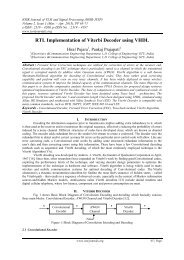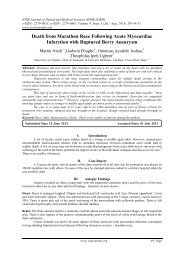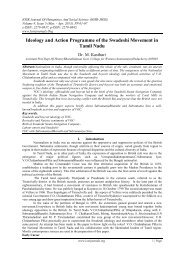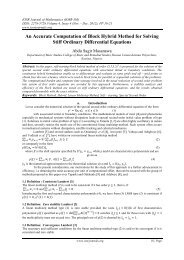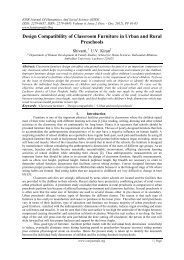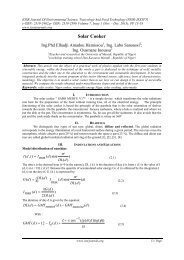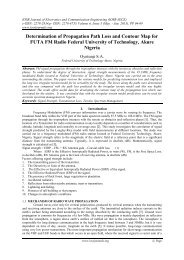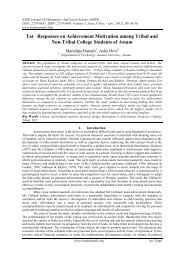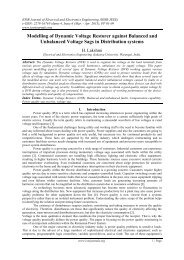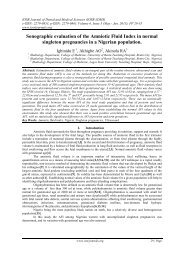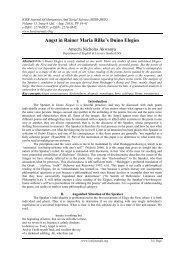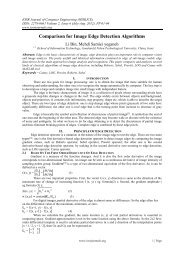Initial Conquest of India by Turks and Their Slaves - IOSR
Initial Conquest of India by Turks and Their Slaves - IOSR
Initial Conquest of India by Turks and Their Slaves - IOSR
You also want an ePaper? Increase the reach of your titles
YUMPU automatically turns print PDFs into web optimized ePapers that Google loves.
Local perspective, aspiration <strong>and</strong> women empowerment in housing development in Africa: Nigeria<br />
III. Method Of Data Collection And Analysis<br />
Data used in the paper were obtained from a cross-sectional survey <strong>of</strong> 721 households in Ibadan, Oyo<br />
State, Nigeria. The survey was undertaken between November 1999 <strong>and</strong> March 2001. The sampling frame<br />
utilized was the total number <strong>of</strong> estimated households in Ibadan municipal area as <strong>of</strong> 1999. The average<br />
household size declared for Nigeria in the result <strong>of</strong> the National Population Commission (NPC) 1995/96<br />
household survey is 4.48. This was used to divide the projected 1999 population <strong>of</strong> each locality as defined <strong>by</strong><br />
the National Population Commission (NPC) in the Ibadan municipal area to get an estimate <strong>of</strong> the number <strong>of</strong><br />
households. To make for effective <strong>and</strong> objective coverage, due to non availability <strong>of</strong> the list <strong>of</strong> all households in<br />
each locality in Ibadan, the number <strong>of</strong> questionnaires administered in each locality was proportional to the total<br />
number <strong>of</strong> estimated households in each locality. For the purpose <strong>of</strong> intra-urban analysis, each <strong>of</strong> the locality in<br />
Ibadan municipal area as defined <strong>by</strong> the National Population Commission (NPC) was accordingly sorted into<br />
four residential areas – high density residential area (comprising traditional core high density residential area <strong>of</strong><br />
Ibadan <strong>and</strong> non-traditional core high density residential area), medium density residential area <strong>and</strong> low density<br />
residential area - according to where it was located following existing studies on Ibadan metropolis (Mabogunje,<br />
1962, 1968; NISER, 1988; Ayeni, 1982; 1994; Filani et al, 1994; Abumere, 1994). For example, the traditional<br />
core high density or indigenous areas <strong>of</strong> Ibadan correspond roughly with Mabogunje‟s (1962) core <strong>and</strong> older<br />
suburbs <strong>and</strong> Ayeni‟s (1982) high density residential areas. Also the non-traditional core high density residential<br />
areas roughly correspond with NISER‟s (1988) new unplanned fringe <strong>and</strong> part <strong>of</strong> Ayeni‟s high density. The<br />
medium density roughly corresponds with Ayeni‟s (1982) classification <strong>of</strong> medium density residential areas <strong>and</strong><br />
Mabogubje‟s (1962) newer eastern <strong>and</strong> western suburbs as well as post 1952 developments <strong>and</strong> NISER‟s (1988)<br />
intermediate zone. Both non-traditional core high density <strong>and</strong> medium density residential areas correspond with<br />
Abumere‟s (1994) zone <strong>of</strong> market forces. The low density residential areas correspond with Ayeni‟s (1982)<br />
classification <strong>of</strong> low density residential areas, Mabogunje‟s (1962) Bodija/Reservation <strong>and</strong> Estates, NISER‟s<br />
(1988) zone <strong>of</strong> planned settlement <strong>and</strong> Abumere‟s (1994) government zone or institutional zone (see Fig. I).<br />
Key<br />
Lake s<br />
Ra il Line<br />
Majo r Ro ad<br />
Du al C arriage wa y / E xpress wa y<br />
Residential Zones<br />
Trad ition al core high d ensity<br />
No n t ra dition al co re hig h d en sit y<br />
Med ium de nsity<br />
Low d ens it y<br />
NISER<br />
UNIVERSIT Y OF<br />
IBADAN<br />
T o O yo<br />
OJOO<br />
OR OGUN<br />
AGBOW O<br />
OD OGBO ARM Y<br />
BAR RACKS<br />
APAT A<br />
To Eruwa<br />
To Abeo kuta<br />
IDO RD<br />
M OOR<br />
PLAN TATION<br />
IDI - ISIN<br />
OD O ON A<br />
OLUYOLE<br />
EXT ENSION<br />
JERICH O<br />
GR A<br />
AD EOYO<br />
STAT E<br />
HOSPIT AL<br />
OD O ON A<br />
ELEW E<br />
IYAGANKU<br />
IJOKOD O<br />
ELEYELE<br />
SABO<br />
OKE BOLA<br />
CHALLENGE<br />
FELELE<br />
THE POLYT ECHN IC ,<br />
IBAD AN<br />
EKOT EDO<br />
DUGBE<br />
OKE ADO<br />
SAN GO<br />
OKE IYUN U<br />
OR EMEJI<br />
MOKOLA<br />
OKE ARE<br />
ELET A<br />
MOLETE<br />
BER E<br />
SAN YO<br />
UCH<br />
OKE<br />
AR EMO<br />
OLD BODIJA<br />
SEC RETAR IAT<br />
OW OD E<br />
ILETITU N<br />
AGOD I<br />
GR A<br />
OJE<br />
KON GI<br />
IKOLABA<br />
OD IN JO<br />
AGU GU<br />
ASH I<br />
OLOR UNSOGO<br />
APER IN<br />
BASOR UN<br />
IW O R OAD<br />
NEW IFE ROAD<br />
T o Lag os<br />
LAGELU IN D.ESTATE<br />
N<br />
4 0 4 Kilometers<br />
Fig. I: Ibadan showing residential density areas<br />
Source: Adapted from Mabogunje (1962); NISER (1988); Ayeni (1982; 1994); Abumere (1994)<br />
www.iosrjournals.org<br />
18 | Page



